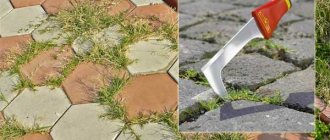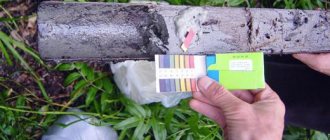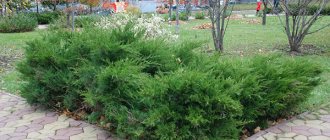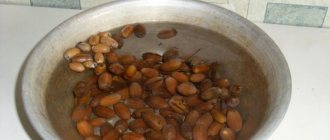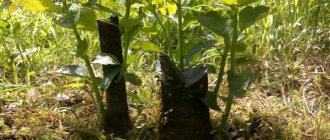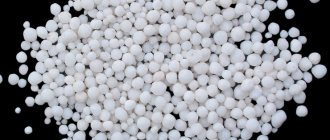Sow green manure
Planting green manure - mustard, peas, oilseed radish and phacelia - will help get rid of moss. When green manure grows and blooms, they need to be mowed and left on the ground. Mown plants form a “carpet” and gradually rot, turning into organic fertilizer. This, in turn, will make the soil neutral, and the moss will die, since it appears mainly on acidic soils with a pH of 4-5.
Vegetable crops can be planted directly into the “carpet” of green manure by making holes in it.
Specifics of moss control in a greenhouse and on trees in the garden
The reasons for the appearance of moss in greenhouses and greenhouses are practically no different from those listed above. The first thing to do is to ensure ventilation of the room and monitor the air temperature. An effective addition would be to treat all wooden surfaces with soapy water and remove the top layer of soil (at least 3-5 cm). Moss on trees can be removed mechanically - using a brush with stiff bristles or a wooden scraper, then treat the cleaned area with a solution of copper sulfate (3%). Some articles advise using metal brushes and scrapers, but this may damage the wood.
It is advisable to clean the bark of trees from moss in early spring, since it hides many garden pests from the cold.
You can learn how to deal with bryophytes on garden trees from the video presented:
Cover with black film
Black covering film helps get rid of moss, especially the most dangerous one - Marchantia. It is enough to spread the film sheet, press it along the edges with bricks and leave it for 1-2 months. Without light and oxygen, the moss will die, and along with it other weeds. The soil will become loose and easy to work.
It is better to lay the film in the spring, as soon as the air temperature stops dropping below zero.
Recommendations for destroying moss
Most often, moss grows in the shade, so it is necessary to get rid of shaded areas on the site.
Tips to follow:
- Moss loves the depressions and uneven areas of moist soil. In the lowlands, water is better retained, which creates favorable conditions for it. Level the area and add sand to improve drainage.
- Moss prefers hard soil, so it is afraid of aeration of the root system. After adding sand to the soil, to increase aeration, it is recommended to pierce the turf with a fork to a depth of 10 cm. For large lawns, manual and mechanical aerators are used.
- Too short grass on your lawn can also cause moss to become active. Try to mow the lawn grass to a height of 5.5 cm every week. This increases the aeration of the soil and reduces its moisture.
- Lack of nutrients is another reason for moss growth. In early spring, it is necessary to carry out complex fertilizing with mineral nitrogen fertilizers. After this, the plant may disappear on its own.
- If the lawn is infected with moss in places where you cannot increase the light (near the walls of the house, near the fence, etc.), gardeners advise sowing this sector with shade-tolerant grasses: red fescue or meadow grass.
- In order to deprive moss of favorable conditions, preserve cultural plantings and increase their productivity, high beds are built, limited by wooden walls. The soil for them is specially prepared and laid out in layers.
Rake the soil
In addition to the method of planting green manure, the soil can be deoxidized with ash, lime or dolomite.
A simple technique will help determine whether the soil is acidified or not. You need to pour 5 tbsp into the bottle. l. warm water. Add 1 tsp. crushed chalk and 2 tbsp. l. soil, put a rubber fingertip on the neck. Next, shake the container for 5 minutes. If the fingertip is filled with gas and inflated, then the soil is acidic. You can also check the pH level using litmus paper.
To deoxidize the soil, you need to add lime, ash or dolomite flour to it at the rate of 50 kg per 100 m². It is acceptable to use chalk ground into flour, which consists of 50% calcium oxide, in contrast to dolomite, which contains only 30% of this element.
Other tips
As you can see, moss is an unpleasant pest that can cause gardeners and summer residents a lot of problems and worries. However, this annoying aggressor can be defeated if preventive measures are systematically implemented, as well as if we begin to destroy it correctly and in a timely manner.
And yet, when starting to fight the parasite, you should think about options for using it to benefit yourself and your garden.
For example, moss can be used during decoration or landscaping. This green plant will look very impressive at the bottom of artificial reservoirs, in the recesses between road slabs, on the surfaces of flower beds or sculptures.
There are many different ways to decorate your summer cottage with moss. However, this is a completely different topic.
Use herbicides
Chemical preparations such as glyphosate-containing herbicides, iron or ammonium sulfates are also effective. For example, 90 ml of ferrous sulfate is diluted in 20 liters of water. This volume will be enough to process 300 m² of soil.
Herbicides come in powder and granular forms. Powder is added to the soil manually or using a garden seeder. After applying chemicals, the soil must be watered. Liquid ones are more convenient to administer using a watering can or wide brush and apply to small areas.
Five days after treatment, the moss will begin to turn black and die. After two weeks, the drug must be reapplied.
How to remove moss from the soil in the garden
We have determined that moss is not the most welcome guest in the garden plot. Therefore, below are effective methods of getting rid of it, tested from our own experience.
Soil deoxidation
The moss on the site itself is already an indicator of acidification. However, before taking active steps, I still recommend that you determine the pH of the substrate using precise methods. You can use litmus tests, which are available in garden centers today.
litmus paper
If your fears are confirmed, then you need to act according to the algorithm:
- Deoxidize the soil. Use good old fashioned liming here.
- Periodically apply mineral and organic fertilizers - compost, manure.
- Plant plants that are resistant to alkaline conditions.
The simplest deoxidation method is liming. 100-200 g of substance is required per 1 m2. The best time for the procedure is autumn, after harvesting, before digging.
Reducing humidity
Reducing the soil moisture in an area affected by moss is another way to get rid of this plant. Most likely, the problem arose in an area with poor drainage and too heavy a clay substrate. The water stagnates and slowly drains away.
Every year I dig and update grooves to drain melt and rain water. An effective way is to organize a drainage system:
- Along the perimeter of the garden I dig grooves with a depth of 50 cm.
- I lay drainage pipes, pre-wrapped with geotextile, at the bottom of the recesses.
- I lead the pipes to a barrel dug into the ground.
- I’m already draining the barrel to drain excess water into the ditch.
- I bury it with a mixture of gravel and earth.
Another solution is to soften, loosen, and improve the structure of the soil. For these purposes, I periodically add river sand and humus. As a preventative measure, I promptly remove plant debris and straw.
An effective measure throughout the season is adjusting watering schedules. Excessive water procedures and watering at dusk are the cause of the appearance of moss. You need to be especially careful with watering in spring and autumn - the moss that appears during these seasons will be the most indestructible.
Weed control
Remove weeds from your garden beds periodically. Under their shade, optimal conditions are created for the life and spread of moss.
It would also be a good idea to loosen areas with a dense earthen crust covered with moss. I use a fine-tooth rake in the garden beds and lawnmower blades on the lawn.
Fertilizing
To prevent the area from being occupied by moss, focus on applying fertilizers with a high content:
- nitrogen;
- gland;
- potassium
The most effective for this problem are ammonium nitrate and nitroammophoska. It is equally important to annually apply organic fertilizers in sufficient quantities - humus, pine needles or compost. Their worthy alternative is green manure. This will kill “two birds with one stone”: saturate the soil with nitrogen, plant the area with a dense “carpet” of green manure that prevents the spread of moss.
fertilizer for the garden
Mulching
Another simple and useful way to remove moss is to mulch the area with natural, natural compounds. I use sawdust and straw mulch. Pine needles and tree bark have also proven themselves well.
Fighting shading in the garden
As a rule, moss prefers shaded areas. To get rid of its presence in these areas, you can:
- Lighten the area. Remove unnecessary branches of a spreading tree, trim dense bushes.
- Plant the area with shade-loving crops. For example, hydrangea, fern, hellebore, etc.
Manual removal
As for the physical, manual removal of moss, this is a simple task: it has superficial small “roots”. Therefore, you can get rid of the unwanted neighbor by simply loosening it with a rake. There is also a less force-intensive method: cover the area affected by moss with non-woven black material. Do not remove the film until the weed is completely dead. Then remove and burn to prevent its spores from spreading.
If you observe the dominance of moss in the area, take other measures:
- Cut it off along with the top layer of soil.
- Lime the area: cover the surface of the soil with quicklime, and after a day, water the soil with water to slak it.
- Treat the area with a motorized cultivator. If the area is small, manual digging is also suitable.
- If desired, the removed top layer of soil saturated with harmful spores can be replaced with fresh, uninfected one.
- Cover the area with a good layer of natural mulch - sawdust, bark, pine needles, straw, etc.
Chemical countermeasures
If paths, lawns, areas not sown with cultivated plants are overgrown with moss, you can apply a chemical composition to save time:
- A solution of glyphosate-containing herbicides.
- Iron sulfate solution: 90 ml of the substance - per 20 liters of water.
- Copper sulfate solution: 50-150 ml - per 16 liters of water.
- A solution of iron or copper sulfate with a concentration of 5%. For 1 hectare of land, 2 liters of composition are required.
- Soap solution, baking soda, kitchen dishwashing detergent: 200 g (200 ml) per 2 liters of heated water. Please note that such a harmless solution can only provide a temporary effect.
- English remedy: for 4 liters of water - 1 tbsp. spoon of baking soda, ¼ teaspoon. spoons of castile soap, 2 tbsp. spoons of vegetable oil.
Delete manually
This is a radical method of combating moss, which consists of mechanically removing the affected layer of earth. It can be used either independently or in addition to chemical treatment.
First of all, with a wide shovel you need to remove the top layer of soil along with the vegetation. Sprinkle a thin layer of lime onto the cleaned soil. After a day, water it and let it dry completely. Then fill in new soil.
Spreads a green carpet
A smooth green lawn is the dream of every gardener. But a beautiful lawn in the form of moss is unlikely.
Before eradicating thickets of dense green carpet, it is worth finding out the cause of its occurrence and understanding what conditions are favorable for its reproduction.
Moss is a plant that can take root where others cannot. It has no roots or flowers and reproduces by spores. This tenacious plant appeared long before man began to cultivate the land.
The reason for the appearance of this weed is:
- increased soil acidity;
- soil depletion;
- high humidity and poor drainage properties of the soil;
- dark areas;
- accumulation of wood or construction waste;
- Lawn mowing too low.
Moss grows quickly and oppresses cultivated plants and suppresses the growth of lawn grass. The plant’s ability to accumulate and retain water leads to excess moisture and increased soil acidity. The green enemy has great resistance to bacteria and pests.
There can be several conditions for the appearance of moss. Gardeners often discuss these problems on thematic forums and share their experiences on how to get rid of annoying weeds.
But what if it’s “chemistry”?
Special chemicals significantly speed up the removal of moss. Among them, the most effective can be identified: copper, ammonium and iron sulfates. To prepare the solution you will need 100 ml of any sulfate and 20 liters of water. After mixing the components well, you can begin spraying the mixture throughout the garden. This amount is enough for three hundred square meters.
Many people use a solution of soda, soap or dishwashing detergent to combat moss. To do this, dissolve 200 g of baking soda in 2 liters of warm water and spray it onto the area. But this method will only give a temporary effect.
And one last piece of advice. Take a closer look: if your moss grows so well and it looks beautiful, then maybe it makes sense not to fight it, but to make a lawn out of it that you don’t even have to mow. Moreover, now such moss lawns are in fashion.
TOOLS FOR CRAFTSMAN AND CRAFTSMAN, AND HOUSEHOLD GOODS VERY CHEAP. FREE SHIPPING. THERE ARE REVIEWS.
Below are other entries on the topic “How to do it yourself - for a homeowner!”
- How to grow moss on a plot - 2 ways Decorating a plot with moss - ways...
- Drainage of a wetland - a set of measures Wetland - what to do? If…
- Using salt in the garden (from late blight, onion fly) HOW TO USE SALT IN THE VEGETABLE GARDEN Years...
- How to deal with May beetles - Khrushchev in the garden May beetles in the garden and...
- How to drain melt water from a site - 4 ways Draining melt water in spring -...
- Mandatory work in the garden in the fall: treating the soil, cleaning, etc. Advice from agricultural sciences PREPARING THE PLOT AND VEGETABLE GARDEN FOR...
- We are developing a neglected area - STEP-BY-STEP ACTION PLAN DEVELOPMENT AND IMPROVEMENT OF A NEGLECTED AREA...
Subscribe to updates in our groups and share.
Let's be friends!
With your own hands › Questions and answers › How to deal with moss on the site - means and methods
Determine the cause of the appearance of moss
Unfortunately, controlling mosses is not an easy task. And the first thing that comes to our mind is to remove moss from the surface of the soil. But this event will not last long. Moss reproduces by spores and pieces of stems. After the next rain or watering, everything will start all over again. First of all, it is necessary to eliminate the causes of the appearance of this vegetation. This may include excessive soil moisture and compaction, increased acidity, constant shading of the area and lack of fertilizers in the soil.
You can determine the most likely cause by carefully looking at the moss itself. If the soil is dry or excessively acidic, then it has straight and fairly long shoots, green on top and brown at the base. If the garden is constantly wet, the plant will spread along the ground cover. And if the grass is mowed very low, the plant will spread like a green mat.
